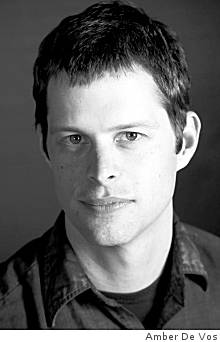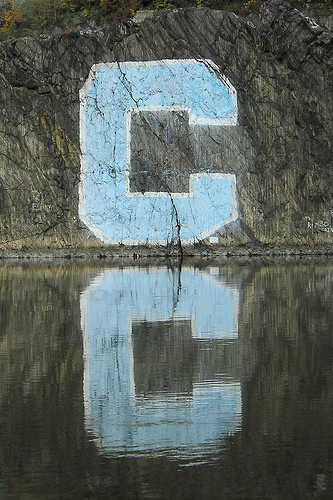On June 12, 2009, I attended a bubble battle in New York. But the event wasn’t really a battle — at least not in the traditional sense. Hundred of people who didn’t know each other gathered in Times Square to blow bubbles. It seemed like such a simple act, but it turned out to be so much more. And I hope that the above film, “Bubbles: A Consideration,” gives anyone who wasn’t able to attend a sense of the possibilities.
Tag / New York

The Bat Segundo Show: John Wray
John Wray appeared on The Bat Segundo Show #282.
John Wray is most recently the author of Lowboy.
Condition of Mr. Segundo: Searching for those who will listen to him in the subway.
Author: John Wray
Subjects Discussed: The ABAB narrative of Lowboy, mirroring schizophrenia within a narrative structure, a sane perspective that assists the reader, subway details, Franz Kafka’s Amerika, real vs. imaginary details, Jonathan Zizmor, the C#/A subway tone, the origin of the character name Heller, Ulysses, resisting eccentric character names, merging two words into one unhyphenated word, A Portrait of the Artist as a Young Man, ideal seating positions in a subway, appealing to a wider audience, balancing the uncompromising literary voice with suspense, comparing the research in Wray’s three books, the difficulties of convincing the reader, Daniel Paul Schreber’s Memoirs of My Nervous Illness, sexual preoccupation and schizophrenia, an intimate third-person voice, the relationship (or lack thereof) between Freud and Schreber, pat summations, urban exploration, the benefits of imagination, the Sikh religion and the end of the Seventh Avenue Line, open interpretations and false connections, respect for the subconscious, the old City Hall station, the dangers of being subsumed by research, writing vs. thinking, graphical segues in prose, B.S. Johnson’s holes, and John Wray vs. John Henderson.
EXCERPT FROM SHOW:
 Correspondent: You have Emily and Lowboy entering at the 14th Street station. I’m going to get subway geeky with you here.
Correspondent: You have Emily and Lowboy entering at the 14th Street station. I’m going to get subway geeky with you here.
Wray: Okay.
Correspondent: I should point out that when you get into Union Square, there is — or there is now and there won’t be very soon — a Virgin Megastore.
Wray: Right.
Correspondent: Was that particular location a deliberate choice on your part?
Wray: (laughs) You know, sometimes there are just these happy accidents that come about either completely by chance or through some sort of action of the subconscious. I’m not really sure. The German editor of Lowboy was very proud of himself for the game of interpretation that he played, which involved a lot of reversals and mirror image analyses, that I guess you could say. He was very proud of himself for having been the only person to discover that the name of the detective in the novel, Ali Lateef..
Correspondent: Either the jazz artist or even the hip-hop artist in Oakland.
Wray: Well, there’s that. Yeah, that was a conscious reference on my part. But this German editor of mine was very proud to have figured out that Lateef spelled backwards is “fetal.”
Correspondent: Yes.
Wray: Which is something that I never thought of. In a million years, I wouldn’t have thought of that. And I still don’t know what he was getting at. But who knows? I mean, it’s quite possible that these things percolate up from the subconscious in some way.
Correspondent: But I also must point out that the 86th Street Station does not have a line that you can see across, as you point out in this particular book. This led me then to believe as I was reading it, “Oh! Is this really real or not?” It was a kind of clue. Deliberate choice on your part?
Wray: Well, I deliberately — I’ve always been a big fan of Franz Kafka’s novel, Amerika. Particularly of the way that Amerika begins. Amerika, of course, being a novel written by someone who had never been to America and who was making deliberate use of the myth of America as a way of addressing many other things. Kafka was not particularly interested in the United States. And in the beginning of the novel Amerika, this boat filled with immigrants enters New York Harbor. And one of the very first sentences describes the Statue of Liberty holding aloft its wonderful gleaming sword.
Correspondent: Yeah.
Wray: Rather than the torch, of course. So in an earlier version of Lowboy, in a bit of a tip of the hat to that novel, I introduced various, fairly overt features into this New York City that would differentiate it from the New York of realistic fiction. Then as the novel evolved, it became more and more naturalistic in a way, and eventually settled into this mode of heightened realism that it now occupies. But there are still certain little vestiges of that earlier alternative New York.
Correspondent: And this would be one of them.
Wray: I think you’ve caught one of them. Yeah.
BSS #282: John Wray (Download MP3)
Listen: Play in new window | Download

C Rock
 The cracked light turquoise paint clings to the gneiss on the Bronx side of Spuyten Duyvil Creek, forming the canvas for a stenciled C, a character cloud with a silver lining representing Columbia University. I can report with some small relief that elite rowers are in short supply on a cold February afternoon. But the Amtrak trains that roll across the bridge to the west of the Henry Hudson can be seen emerging on the Bronx side and disappearing behind the Big C. While the rock itself has defiantly exacted fissures through serious chunks of this not-quite-elliptical letter, the paint sits truer near the stems. And you can walk a good hard slog through Inwood Hill Park, slipping on the presently icy trails under the Henry Hudson Bridge leading southwest to Dyckman Street, and not know a damn thing about how the C came to be. You’ll run into friendly geese, with their sinuous necks jutting as slow and methodical and as graceful as their struts, and encounter a number of maps displaying city department propaganda about all the forest preservation going on. But what of the origins of C Rock itself? Nothing. An unknown letter defying history, standing some sixty feet tall but somehow still managing to upstage the large chunks of ice now breaking in the water.
The cracked light turquoise paint clings to the gneiss on the Bronx side of Spuyten Duyvil Creek, forming the canvas for a stenciled C, a character cloud with a silver lining representing Columbia University. I can report with some small relief that elite rowers are in short supply on a cold February afternoon. But the Amtrak trains that roll across the bridge to the west of the Henry Hudson can be seen emerging on the Bronx side and disappearing behind the Big C. While the rock itself has defiantly exacted fissures through serious chunks of this not-quite-elliptical letter, the paint sits truer near the stems. And you can walk a good hard slog through Inwood Hill Park, slipping on the presently icy trails under the Henry Hudson Bridge leading southwest to Dyckman Street, and not know a damn thing about how the C came to be. You’ll run into friendly geese, with their sinuous necks jutting as slow and methodical and as graceful as their struts, and encounter a number of maps displaying city department propaganda about all the forest preservation going on. But what of the origins of C Rock itself? Nothing. An unknown letter defying history, standing some sixty feet tall but somehow still managing to upstage the large chunks of ice now breaking in the water.
It is commonly understood that a rowing team from Columbia University painted the rock out of school pride. Bill Twomey’s The Bronx suggests an alternate theory: that the rock was painted by engineering students from Columbia and the blue paint was purchased by George Younkheere (along with brushes and rope). In 1994, the New York Times reported that the peninsula was destroyed sometime in 1937 to widen the Harlem River Ship Canal, where the C was later painted. The Times also helpfully informs us that the paint is replenished every few years by Columbia crews. But who? And what authority determines how frequently the rock must be painted? Another Times article four years later informs us that the rock was painted by oarsman in 1955, with then Columbia assistant director of athletics Brian Bodine claiming that the work was done with team members suspended from boatswain’s chairs. But was Bodine there? And how does he know exactly? Are there pictures of the initial rock painting that Columbia is sitting on? (The latter Times article also informs us that there was a touch-up job in 1986. But from my observation, it appeared that the C had been painted a little more recently, perhaps at the stems.)
These shifting details still don’t answer the precise origins of the C, and it may be because the C is perhaps one of New York’s largest items of graffiti. The rock is referred to in some quarters as Geronimo, and there are apparently two physical activities associated with the rock. The first supports the Apache reference transformed into triumphant cry: giddy souls sometimes leap from the top into the creek. The second is reminiscent of that silly climactic scene from the film Gattaca: swim across the creek and back and prove your athletic prowess (and presumably your manhood). The site Inwoodlite claims that C Rock was established on a racist note, but is too diffident to share this with us. It is also known that a Lenape settlement was once situated at the top of the rock. This likewise suggests a clash between civilizations, but perhaps not the kind that the Lenapes would be aware of during their residency.
What’s fascinating is that there haven’t been any legal challenges to the rock. The C was painted and it has endured, quietly endorsed by the Inwood neighborhood and the Bronx dwellers living above the rock. Perhaps it is too unwieldy to rub out. Columbia is understood to have marked its turf on a rock cut by workers, leaving one to wonder whether some ambitious taggers might establish an A Rock and a B Rock somewhere along the Harlem River to ensure an alphabetical symmetry. This will probably not happen. They’ve cracked down on graffiti in the five boroughs, and Ivy Leaguers, it seems, are the only one afforded immunity and a natural canvas. The rest evade bulls and whip out cans and try tagging cars at the ends of subway lines, but their screeds and illustrations, however crude, are washed away to avoid permanence. No such fate for Columbia, whose C may very well be cruder and bolder than the output of today’s taggers.
(Photo credit: jag9889.)
When Is a Bar Not a Bar?
It changes its hours, its temperament, and its reasons for existing faster than the seasons. Faster than some contemporary hostler can rustle up fresh horses or the unseen manager can replace fleeing steeds who take legal tender while tending behind the isthmus separating employee from customer. There are some moments during the year when it serves coffee, and other moments when it dumps these java options in favor of more alcoholic ones. (The latter scenario is the present option. It has resulted in others fleeing to more dependable joints where coffee has been a regular option for at least six months.) The place has a perfectly respectable architecture that possesses hospitable potential: plentiful tables to talk or to read, a tawny aura that isn’t likely to be profiled in Architectural Digest anytime soon, but that might work with the right clientele and the right management. Unfortunately, for those who hope to stay, there’s a revolving door in place: those who own the joint and those who run the joint are fresh-faced neophytes who emerge every two months. And you never know where the previous folks went, even when you ask around. It’s safe to say that this constant confusion about what this place is exactly doesn’t permit a hearty staple of neighborhood regulars. Without even a shred of permanence, it remains a house devoted to transients. And it inexplicably survives.
This establishment blames its current woes on the economy, which was why it recently ejected coffee from its beverage repertoire and truncated its hours. But you can find four or five boisterous talkers on any weeknight itching to turn the place seedy. And one senses a certain resistance to this not entirely unsavory option from the staff, for you can almost always hear them them bitching about crazed drunks and lonely eccentrics who they had to eject.
The folks who hang out at this place are almost never from the neighborhood. They come from SoHo, Queens, and sometimes Inglewood. A few arrive late after watching strippers at the Slipper Room, and deliver fleshy reports to anyone who will listen. A large television is behind the bar, mostly muted. Like most bars, it’s a point of reference for anyone who can’t find some topic to talk about. And there are always things to talk about. Just check your brain in at the door and concentrate on small talk.
Perhaps this place is some outre port in the storm. The place that nobody knows about or cares to acknowledge. The place where anyone who walks in and carries some sign of living somewhere within a five-block radius is viewed with a natural suspicion.
I don’t wish to name this place. There’s a perfectly wonderful bar that I could go to a few blocks down the street, but I’ve long had a soft spot for the underdogs. I am fascinated by this bar’s almost total failure as a business and as a place of natural community, but I likewise harbor some small hope that it will figure itself out. It could very well be that the anxiety now in the national air — the transition from a dopey president who seems as unstoppable as Friday the 13th‘s Jason to a guy who might actually do something — has affected its staff and customers. Or it could very well be that those in the neighborhood are “wiser” than I am, going to the sensible spots where their evenings will be predictable successes. But this seems too easy an option in a city with one of the swiftest gentrification rates in the known world.
I don’t know how long this place will last, but I hope to carry on attending. I suspect I have some modest aspirations as a flâneur. Or perhaps I’m simply waiting around or hoping to instigate some moment in which the people of New York City finally throw off the shackles.
Crave
The economic downturn is shaking up the rabble just south of Times Square. I was walking along Eighth Avenue, and a man leaped at me some fifteen feet from the edge of the sidewalk, grabbing my forearm. There had been a guy who almost tore the lapel off my wool coat last winter. But somehow the man today was more desperate. More determined to seize another’s attention. More compelled to invade personal space. Wanting to survive, needing to matter, bowling alone.
I chatted with a thin woman bundled in a dark pockmarked coat just outside Penn Station who said she needed $12 to get home. She was situated under one of those ramshackle walkways intended to steer pedestrian traffic away from the main sidewalk while some construction rattles on, but that almost always serves as an impromptu shelter in the winter. She told me that I was the only one who talked with her in two hours. Whether her story was true or not, she was pretty hard to miss. Her large cardboard sign had the word STRANDED! in big blocky letters, a kind of Bic-imbued pointillism. The details in her story didn’t add up, but I gave her a dollar that I didn’t really have. There was the man I saw begging for a cigarette just outside a diner. A woman stood with a smile on her face, smoking three cigarettes in a row. The man wouldn’t go away. He was persistent. She didn’t budge. He dived for one of the butts she had dropped on the sidewalk and then asked her for a light. She refused. I had no cigarettes or matches on me. It would have made some difference.
Someone told me yesterday that she had been given $40 and a box to collect her possessions upon submitting her resignation notice. No pay for the last two weeks. The White Castle on Eighth Avenue announces that it’s hiring. Benefits are the big selling point. And it can’t be an accident that a bundle of comfort burgers over there is called a Crave.
Everyone craves a little security these days. More than a White Castle burger, which you have twenty minutes to sit around and eat until they kick you out. If you’re not let go just because, then you’re certainly craven, hoping to keep whatever job you have. Whether it has become necessary to sacrifice a little liberty and empathy to pay the rent is a question I can’t possibly answer. But you can feel the bristling fear in the streets.